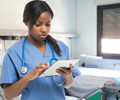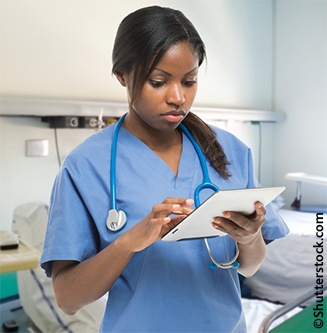
The principles of remote monitoring
In clinical care remote monitoring entails: the collection of patient biometric data (by external or implanted data collection devices) that is relevant to patient disease management (e.g. glucose sensors in the management of diabetes mellitus); or collection of data relevant to management of that device and (if so enabled) biometric data recorded by that cardiovascular implantable electronic device (CIED) relevant to the patient’s disease state (e.g. arrhythmia/heart failure status), when a patient has an active CIED, such as a cardiac pacemaker/implantable defibrillator.
With the advent of cheap and reliable technologies, televisual clinical examination (e.g. in dermatology care) may be employed for patient consultations, but this care application is considered beyond the scope of this brief article.
Inherent in the concept of remote monitoring then is data collection, data analysis, clinical decision-making and an effector arm that provides therapy instructions to the patient, or their carer or a near-to-patient healthcare professional.
Fundamental to the value proposition is the tenet that patient care can be delivered ‘at a distance’, usually in the community, and that this approach either saves cost or improves efficiency and clinical effectiveness. It is implicit that the process offers diagnostic or therapeutic value, or both, and not just the collection of data. Furthermore, it has been an assumption that by removing the need for face-to-face healthcare professional interaction, whether in a healthcare facility (hospital or community medical centre) or the patient’s home, healthcare resources can be focused on expeditious care initiated by the data garnered by the remote monitoring technology and orchestrated through a bespoke care pathway. Whether the monitoring technology is external, wearable or implanted, the usual schema is for it to transmit data wirelessly to an internet-enabled base station in the patient’s home. That data are then lodged on a server and accessed by either dedicated remote monitoring staff in a call centre or by the healthcare team responsible for the clinical care of the monitored patient.
The design and implementation of appropriate care pathways is critical to the success of remote monitoring and data acquisition alone is of no inherent value without an appropriate and timely response. It is, as yet, an unproven assumption that remote monitoring can reduce healthcare costs.
Technology
To be monitored, the patient is equipped with remote monitoring technologies. These mainly take the form of data collecting devices in the home. These may be supplemented by near-patient blood testing equipment. The monitoring technologies are, therefore, specific to the patient’s disease states, and they provide the healthcare professional with data relevant to the monitored patient’s condition. They are disease specific (for example blood pressure monitoring and weight scales in heart failure; glucose monitoring in diabetes). They may be external to the body and used intermittently (e.g. sphygmomanometer cuff), they may be wearable (e.g. a vest with embedded sensors1) or skin-mounted devices (e.g. ambulatory cardiac monitor or glucose monitor2) or devices implanted into the body. In the latter case implanted devices may be for diagnostic purposes only (e.g. a pulmonary artery pressure monitoring system3 or an implanted subcutaneous cardiac rhythm monitor4) or they may be CIEDs, which have enabled within them additional diagnostic capabilities (such as arrhythmia or heart failure monitoring technology).
It is important that both patients and healthcare professionals receive rigorous training in the use of such devices and supporting infrastructure.
Data analysis and actions
The supporting mechanism for data analysis and action can vary widely in their nature and complexity. The processes for remote monitoring technology use are very much a function of the healthcare system into which these technologies are deployed and the disease state which they address, and, thus, there are big differences in service design features both between and within countries. On that background, remote monitoring services are very varied in their scope. In diabetes management, remote monitoring and management is widely practised and frees patients from the drudgery of frequent clinic attendance and complex care paradigms for their management.5 Patient self-care is at a high level with strong patient engagement.6 That is not the case for cardiac disease states, although it is likely that there will be a rapid evolution to aspects of self-care as artificial intelligence processes and sensitivity and specificity of monitoring technologies improve.
With CIEDs remote monitoring has a dual role – the management of the functionality of the implanted technology itself,7 and, depending on technological capability, monitoring of patients’ heart rhythm and heart failure status.8,9 In some healthcare systems, the remote management of CIEDs has been highly adopted so that patients attend in-office clinics for device checks infrequently, and often only for device re-programming. At present, while the technology for remote device programming is available it is not offered in clinical practice due to concerns around clinical responsibility and the risk of malicious interference.
In its simplest form, active remote monitoring for heart failure has used telephone-based patient support.10 However, there are a range of active remote monitoring clinical care approaches and technologies for heart failure, including devices that collect data, such as haemodynamics, thoracic impedance, cardiac arrhythmia, and patient activity.11-13 Small studies have suggested that active remote monitoring may reduce death from heart failure and hospitalisation,9,14 but recent extensive clinical trials have given disappointing results. The Telemonitoring to Improve Heart Failure Outcomes (Tele-HF) Trial,15 the Telemedical Interventional Monitoring in Heart Failure (TIM-HF),16 and the Better Effectiveness After Transition-Heart Failure (BEAT-HF) trial,17 all assessed use of non-implantable remote monitoring technologies in differing care pathways strategies and failed to show benefit for death or hospitalisation compared with usual care, although follow-up was relatively short at six months and patient compliance tended to be suboptimal.
CIEDs often have sophisticated monitoring technologies embedded in them, which are adjunctive to their therapeutic pacing/defibrillator intent. These are intended to identify heart failure deterioration through measurement of parameters, such as intrathoracic impedance, heart rate variability, nocturnal heart rate, patient activity and atrial and ventricular arrhythmia burden. A further design feature of CIEDs has been the use of automated ‘alerts’.11-13 These are issued by the monitoring device (either directly to the patient or to the data monitoring platform) if monitored parameters exceed programmable thresholds considered to indicate heart failure deterioration. Their use (mainly associated with intrathoracic impedance measurement) has been key to care pathway design in many studies of remote monitoring in heart failure. The intention is that the recipient instigates a therapy change, but, as intrathoracic impedance has poor sensitivity and specificity, the result has been that alert-driven care has driven unnecessary hospitalisations and has not reduced death or hospitalisations in monitored patients.11,12,16 It may also be that in the multiple studies using single manufacturer’s devices for CIED monitoring chiefly driven by ‘alerts’, even if they are appropriately generated, they occur late in the course of a heart failure deterioration episode and cannot facilitate pre-emptive therapy.
In contrast to single parameter monitoring, a combined multi-parameter heart failure diagnostic algorithm based on observational data showed that patients at higher risk of hospitalisation for heart failure could be identified within a 30-day window.18 Also, the Implant-based Multiparameter Telemonitoring of Patients with Heart Failure (IN-TIME) study19 used CIED monitoring of tachyarrhythmia, sub-optimal biventricular pacing, increased ventricular extrasystolic activity and decreased patient activity, with data sent daily to a central monitor. This approach was compared with usual care in 664 patients across 36 centres over 12 months and there was a reduction in a combined end point of death from any cause (an effect seen in patients with atrial fibrillation), with improved patient global self-assessment and New York Heart Association (NYHA) class change. However, the Monitoring Resynchronization Devices and Cardiac Patients (MORE-CARE) trial20 (which was stopped early because of slow enrolment) used ‘alerts’ for intrathoracic impedance and atrial tachyarrhythmias in 865 of a planned 1,720 enrolled patients, and at 24 months follow-up (patients enrolled within eight weeks of an implant of a cardiac resynchronisation therapy defibrillator [CRT-D] device) showed no difference in the primary end point of all-cause mortality or hospitalisation for cardiovascular or device-related reasons.
To date, the largest study, CIED-based Remote Monitoring of Heart Failure (REM-HF),21 used CIEDs from three manufacturers and tried to create a remote monitoring strategy reflective of real-world clinical practice. It was neutral for a combined end point of heart failure hospitalisation and mortality with 1,650 patients followed for a median of 2.7 years. In contrast to the use of diagnostic features within therapeutically-indicated CIEDs, two monitoring-only cardiac implantable technologies have undergone clinical trial assessment. In one, a pressure sensor mounted on an intravascular lead and connected to an implanted monitoring device giving continuous right ventricular pressure monitoring failed to achieve significant reduction in hospitalisations,22 but in the second, a wireless pulmonary artery haemodynamic monitor that allows physician-instructed medication change to achieve a target pulmonary artery pressure resulted in a 33% reduction in hospitalisations at six months compared with usual care.23 Perhaps, if patients are managed to remain within a target zone that could be indicative of optimal physiological status, then better outcomes can be achieved. Overall, the outcome of studies for remote monitoring for heart failure have been disappointing in that a primary end point for hospitalisation and mortality reduction has not been met, and cost-effectiveness not proven. That said, there are new technologies on the horizon, which promise much greater sensitivity and specificity in heart failure deterioration detection,24 and offer the prospect of timely intervention, as long as the technology is implemented in a suitably designed care pathway that will allow it to express its potential.
Reimbursement for remote monitoring
Mechanisms for reimbursement for remote monitoring services are highly variable, both within the UK, and more broadly across healthcare systems. Prevention of early rehospitalisation has become a key metric of better care and, as such, is linked to punitive financial measures against healthcare providers in some countries. As such, monitoring mechanisms that can pre-empt rehospitalisation may have value. However, in-office consultations are revenue generators for healthcare professionals and hospitals in some systems, and loss of such activity to a remote-monitoring service is resisted, as provision of such a service carries no reimbursement. In the UK, some centres have negotiated a system of alert-driven reimbursement for their monitoring services, while others have failed to secure any reimbursement at all. Across Europe, it is generally the case that healthcare systems have not offered reimbursement that is sufficient to drive uptake of remote-monitoring technologies and strategies. Although the National Institute for Health and Care Excellence (NICE) has considered aspects of remote-monitoring technologies, there is, as yet, no over-arching guidance. If more powerful evidence emerges for the clinical and cost-effectiveness of remote monitoring25 then it will be necessary for there to be a change in political will for uptake to be encouraged.
Conclusion
Remote monitoring, generally, has yet to be proven to be a truly clinically and cost-effective tool, although technology advances hold out hope for major improvement with, in the case of heart failure for example, much greater sensitivity and specificity for deterioration prediction. The potential value of remote monitoring to the healthcare economy can only be fully realised with major healthcare system redesign and reimbursement mechanisms that encourage uptake of clinically proven technologies.
Key messages
- Remote monitoring, with disease-specific monitoring technologies, is increasingly widely available
- The design and implementation of appropriate care pathways is critical to the success of remote monitoring
- A key element affecting widespread adoption of remote monitoring is reimbursement, which is highly variable
- It is, as yet, an unproven assumption that remote monitoring can reduce healthcare costs
Conflict of interest
JMM is an employee of Boston Scientific Ltd.
Articles in this supplement:
Introduction
Current and future perspectives on cardiac pacing
A brief history of cardiac pacing in the UK
Cardiac resynchronisation therapy – developments in heart failure management
Drugs with devices in the management of heart failure
His-bundle pacing: UK experience and HOPE for the future!
Leadless pacing
Techniques in pacemaker and defibrillator lead extraction
Remote follow-up of ICS: a physiologist’s experience
References
1. Appelboom G, Camacho E, Abraham ME et al. Smart wearable body sensors for patient self-assessment and monitoring. Arch Public Health 2014;72:28. https://doi.org/10.1186/2049-3258-72-28
2. Andrews JT, Solanki J, Choudhary OP et al. Towards a wearable non-invasive blood glucose monitoring device. J Phys Conf Ser 2012;365:012004. https://doi.org10.1088/1742-6596/365/1/012004
3. Ohlsson A, Nordlander R, Bennett T et al. Continuous ambulatory haemodynamic monitoring with an implantable system: the feasibility of a new technique. Eur Heart J 1998;19:174–84. https://doi.org/10.1053/euhj.1997.0563
4. Tomson TT, Passman R. The Reveal LINQ insertable cardiac monitor. Expert Rev Med Devices 2015;12:7–18. https://doi.org/10.1586/17434440.2014.953059
5. Michaud TL, Siahpush M, Schwab RJ et al. Remote patient monitoring and clinical outcomes for postdischarge patients with type 2 diabetes. Popul Health Manag 2018;online first. https://doi.org/10.1089/pop.2017.0175
6. Hannon TS, Yazel-Smith LG, Hatton AS et al. Advancing diabetes management in adolescents: comparative effectiveness of mobile self-monitoring blood glucose technology and family-centered goal setting. Pediatr Diabetes 2018;19:776–81. https://doi.org/10.1111/pedi.12648
7. Zanotto G, Cassinadri E, Visentin E et al. From in-clinic to fully remote follow-up model for pacemaker patients: a four-year experience. Int J Cardiol 2018;258:151–3. https://doi.org/10.1016/j.ijcard.2018.01.122
8. Small RS. Integrating device-based monitoring into clinical practice: insights from a large heart failure clinic. Am J Cardiol 2007;21:17G–22G. https://doi.org/10.1016/j.amjcard.2007.02.038
9. Böhm M, Drexler H, Oswald H et al. OptiLink HF Study Investigators. Fluid status telemedicine alerts for heart failure: a randomized controlled trial. Eur Heart J 2016;37:3154–63. https://doi.org/10.1093/eurheartj/ehw099
10. Clark RA, Inglis SC, McAlister FA et al. Telemonitoring or structured telephone support programmes for patients with chronic heart failure: systematic review and meta-analysis. BMJ 2007;334:910–11. https://doi.org/10.1136/bmj.39156.536968.55
11. Cowie MR, Conraads V, Tavazzi L, Yu,CM. Rationale and design of a prospective trial to assess the sensitivity and positive predictive value of implantable intrathoracic impedance monitoring in the prediction of heart failure hospitalisations: the SENSE-HF Study. J Card Fail 2009;15:394–400. https://doi.org/10.1016/j.cardfail.2008.12.004
12. van Veldhuisen DJ, Braunschweig F, Conraads V et al. DOT-HF Investigators. Intrathoracic impedance monitoring, audible patient alerts, and outcome in patients with heart failure. Circulation 2011;124:1719–26. https://doi.org/10.1161/CIRCULATIONAHA.111.043042
13. Boriani G, Da Costa A, Ricci RP et al.; MORE-CARE Investigators. The MOnitoring Resynchronization dEvices and CARdiac patiEnts (MORE-CARE) randomized controlled trial: phase 1 results on dynamics of early intervention with remote monitoring. J Med Internet Res 2013;15:e167. https://doi.org/10.2196/jmir.2608
14. Klersy C, De Silvestri A, Gabutti G, Regoli F, Auricchio A. A meta-analysis of remote monitoring of heart failure patients. J Am Coll Cardiol 2009;54:1683–94. https://doi.org/10.1016/j.jacc.2009.08.017
15. Chaudhry SI, Mattera JA, Curtis JP et al. Telemonitoring in patients with heart failure. N Engl J Med 2010;363:2301–09. https://doi.org/10.1056/NEJMoa1010029
16. Koehler F, Winkler S, Schieber M et al.; Telemedical Interventional Monitoring in Heart Failure Investigators. Impact of remote telemedical management on mortality and hospitalizations in ambulatory patients with chronic heart failure: the telemedical interventional monitoring in heart failure study. Circulation 2011;123:1873–80. https://doi.org/10.1161/CIRCULATIONAHA.111.018473
17. Ong MK, Romano PS, Edgington S et al. Effectiveness of remote patient monitoring after discharge of hospitalized patients with heart failure: the Better Effectiveness After Transition-Heart Failure (BEAT-HF) randomized clinical trial. JAMA Intern Med 2016;176:310–18. https://doi.org/10.1001/jamainternmed.2015.7712
18. Whellan DJ, Ousdigian KT, Al-Khatib SM et al. PARTNERS Study Investigators. Combined heart failure device diagnostics identify patients at higher risk of subsequent heart failure hospitalizations. Results from PARTNERS HF (Program to Access and Review Trending iNformation and Evaluate coRrelation to Symptoms in patients with heart failure) study. J Am Coll Cardiol 2010;55:1803–10. https://doi.org/10.1016/j.jacc.2009.11.089
19. Hindricks G, Taborsky M, Glikson M et al.; IN-TIME study group. Implant-based multiparameter telemonitoring of patients with heart failure (IN-TIME): a randomised controlled trial. Lancet 2014;384:583–90. https://doi.org/10.1016/S0140-6736(14)61176-4
20. Boriani G, Da Costa A, Quesada A et al. Effects of remote monitoring on clinical outcomes and use of healthcare resources in heart failure patients with biventricular defibrillators: results of the MORE-CARE multicentre randomized controlled trial. Eur J Heart Fail 2017;19:416–25. https://doi.org/10.1002/ejhf.626
21. Morgan JM, Kitt S, Gill J et al. Remote management of heart failure using implantable electronic devices. Eur Heart J 2017;38:2352–60. https://doi.org/10.1093/eurheartj/ehx227
22. Bourge RC, Abraham WT, Adamson PB et al. Randomized controlled trial of an implantable continuous hemodynamic monitor in patients with advanced heart failure: the COMPASS-HF study. J Am Coll Cardiol 2008;51:1073–9. https://doi.org/10.1016/j.jacc.2007.10.061
23. Abraham WT, Stevenson LW, Bourge RC, Lindenfeld JA, Bauman JG, Adamson PB; CHAMPION Trial Study Group. Sustained efficacy of pulmonary artery pressure to guide adjustment of chronic heart failure therapy: complete follow-up results from the CHAMPION randomised trial. Lancet 2016;387:453–61. https://doi.org/10.1016/S0140-6736(15)00723-0
24. Boehmer JP, Hariharan R, Devecchi FG et al. A multisensor algorithm predicts heart failure events in patients with implanted devices: results from the MultiSENSE study. J Am Coll Cardiol Heart Fail 2017;5:216–225. https://doi.org/10.1016/j.jchf.2016.12.011
25. Burri H, Sticherling C, Wright D, Makino K, Smala A, Tilden D. Cost-consequence analysis of daily continuous remote monitoring of implantable cardiac defibrillator and resynchronization devices in the UK. Europace. 2013;15:1601–08. https://doi.org/10.1093/europace/eut070


